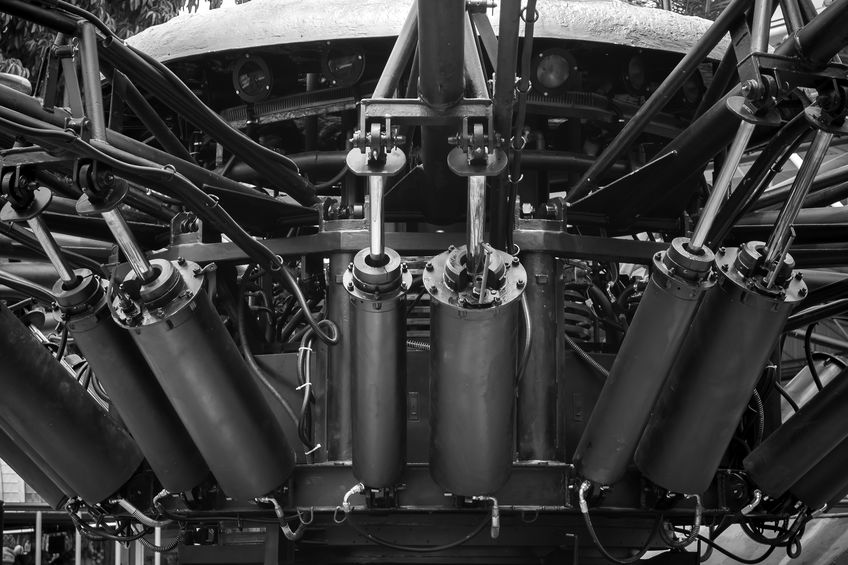Hydraulic Cylinders Enable Precision Motion and Power in Automation
While hydraulic cylinders are usually considered for heavy-duty applications such as construction equipment, they also play a critical role in manufacturing automation systems and other integrated automation systems, providing precision motion and power to these applications. This blog aims to explore the working principle of hydraulic cylinders, explain the difference between cylinders and actuators and showcase a variety of applications where their precise movements and high strength really shine.

Hydraulic Cylinders Defined
To fully appreciate all that hydraulic cylinders have to offer when used as components in integrated automation systems, it’s important to fully understand what makes them tick. These mechanical devices rely on pressurized hydraulic fluid to produce motion and force.
Basic hydraulic cylinder components include:
- A cylinder barrel serves as the main body of the device and contains the pressurized hydraulic fluid.
- A cylinder base or cap encloses one end of the barrel and provides a mounting point.
- A cylinder head closes the other end of the barrel and contains the rod sealing components.
- A piston transfers force from the fluid to the piston rod.
- A piston rod connects the hydraulic actuator to the machine component that will be moving.
- A seal gland prevents oil leakage and houses the seal and bearing elements.
Hydraulic cylinders also rely on the use of a hydraulic pump and a reservoir for fluid storage. In pump systems, valves regulate the flow of the liquid and control the pressure providing precise motion. This type of pump system allows hydraulic cylinders to provide motion in many applications, such as mobile construction and industrial manufacturing equipment.
Modern, smart hydraulic cylinders may also include integrated sensors and connectivity to provide real-time data that helps identify maintenance or performance issues.
Hydraulic cylinder operation begins when hydraulic fluid enters one side of the cylinder and pushes on the piston. As the fluid pressure intensifies, the piston begins to move, creating linear motion. Finally, this motion is transferred to the piston rod and then to the machinery that it serves.
These precision motion control components are available as single or double acting. Single-acting hydraulic cylinders are pressurized for motion in just one direction, making them a great choice for lifting applications. Double-acting versions can move loads along the horizontal plane, the vertical plane and any other plane of motion, making them flexible enough for use in a broad range of applications.
Hydraulic cylinders are available in the following styles to suit a variety of applications:
- Tie rod style: Tie rods are commonly used provide strength and stability in hydraulic cylinders and are often found in industrial and manufacturing automation systems.
- Welded body: With a sturdy, robust and reliable welded body, welded-body hydraulic cylinders excel in heavy-duty applications, such as construction and agricultural machinery.
- Telescopic cylinders: As the name implies, these hydraulic cylinders can provide extended stroke capabilities, making them ideal for automation or mobile applications in which a long range of motion is required.
It should be noted here that the terms “cylinder” and “actuator” are often used interchangeably; however, there is a difference between these two motion control devices and that lies in their design, function and application.
Cylinders are mechanical devices, and a type of actuator, that convert fluid power into linear mechanical force and are commonly used in industrial machinery, robots, and heavy-duty applications to provide lifting, pushing, pulling or holding motions. On the other hand, actuators are devices that are used to control or move a mechanism or a system and are available in different forms and powered by energy that is supplied either hydraulically, pneumatically, electrically or mechanically.
Bringing Precise Motion Control to Integrated Automation Systems
While hydraulic cylinders offer many benefits, one of the greatest is their ability to provide precise motion control that allows fine-tuned and consistent speed, pressure and force in applications that demand accuracy, as well as strength and speed.
Sturdy hydraulic cylinder parts and robust construction enable a high power-to-size ratio, which means they can provide significant force in a small footprint and perform reliably in heavy-duty and industrial applications, such as manufacturing automation systems, as well as challenging industrial, construction and agricultural environments.
Using Hydraulic Cylinders in Integrated Automation Systems
The speed, strength and precise motion control provided by these devices, along with their robust construction, makes hydraulic cylinders versatile enough to perform in a range of applications.
Hydraulic cylinders are best known for their ability to push, pull and lift the heaviest of loads, which means they are commonly found in heavy-duty applications, such as excavators, loaders, graders, bulldozers and other construction vehicles, as well as agricultural equipment, such as balers, harvesters, tractors and loaders.
They are also suitable for manufacturing automation systems where significant force and power are needed to operate machinery, such as compactors, material handling equipment, presses, lifts and injection molding equipment. Manufacturing equipment such as packaging machinery may also use hydraulic cylinders to lift, position and package products.
Industrial robots and advanced machines are applications where precision motion control and high-force capabilities allow them to manage complex tasks that require accuracy, reliability and repeatability.
To learn more about how the precision motion control, strength and reliability provided by hydraulic cylinders can be advantageous in integrated automation systems such heavy machinery; manufacturing and industrial equipment; and robotics and advanced machinery, please contact JHFOSTER, a Tavoron company today.
